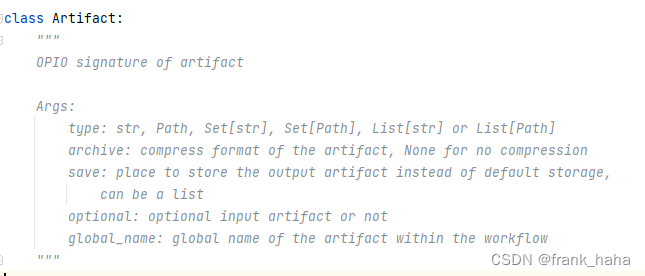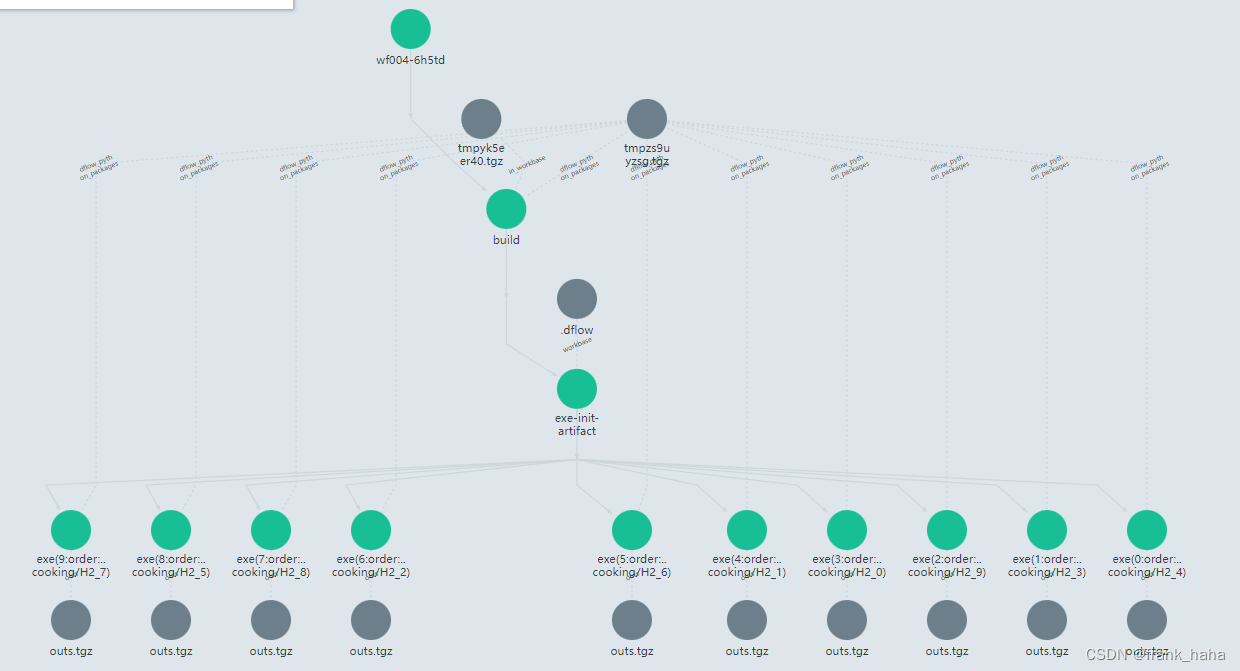为了梳理学习dflow时遇到的知识点,我决定开这一个系列记录自己的学习过程。当然了,最好是去看 文档
本文,我们将讨论dflow的一个feature,Subpath_slices,并在最后写一个应用。
阅读原测试文件
test_subpath_slices.py 在源码example目录下
文件开始定义了两个OP
class Prepare(OP):
def __init__(self):
pass
@classmethod
def get_input_sign(cls):
return OPIOSign({
})
@classmethod
def get_output_sign(cls):
return OPIOSign({
'foo': Artifact(List[str], archive=None)
})
@OP.exec_sign_check
def execute(
self,
op_in: OPIO,
) -> OPIO:
with open("foo1.txt", "w") as f:
f.write("foo1")
with open("foo2.txt", "w") as f:
f.write("foo2")
op_out = OPIO({
'foo': ["foo1.txt", "foo2.txt"]
})
return op_out
class Hello(OP):
def __init__(self):
pass
@classmethod
def get_input_sign(cls):
return OPIOSign({
'foo': Artifact(str)
})
@classmethod
def get_output_sign(cls):
return OPIOSign()
@OP.exec_sign_check
def execute(
self,
op_in: OPIO,
) -> OPIO:
with open(op_in["foo"], "r") as f:
print(f.read())
return OPIO()
第一个OP没有输入,输出是一个list格式的artifact,值得注意的是,这里有一个label是archive=None
点进注释可以看到,archive=None 指不对文件进行压缩

第二个OP是读入单个文件,然后对该文件进行一些操作,没有输出
最后,我们来看套的壳
wf = Workflow("subpath-slices")
prepare = Step("prepare",
PythonOPTemplate(Prepare, image="python:3.8"))
wf.add(prepare)
hello = Step("hello",
PythonOPTemplate(Hello, image="python:3.8",
slices=Slices(sub_path=True,
input_artifact=["foo"]
)
),
artifacts={"foo": prepare.outputs.artifacts["foo"]})
wf.add(hello)
wf.submit()
while wf.query_status() in ["Pending", "Running"]:
time.sleep(1)
assert(wf.query_status() == "Succeeded")
首先是在wf里加入了prepare,然后把
prepare的输出传给了hello的输入,并在Slice里指定了要切割的对象,sub_path=True就可以了!!
这相当于我以前代码里:
- 把这个文件夹传给第二步
- 在第二步里进入文件夹,然后
os.listdir('./')获取该文件夹下的每个工作目录,再进入该目录完成工作!!
使用sub_path之后就是:
- 把文件夹传给第二步
- 第二步使用slice之后,只关心工作目录里的业务操作即可。
应用案例
第一个OP实现工作目录的搭建
class BuildWithSub(OP):
def __init__(self):
pass
@classmethod
def get_input_sign(cls):
return OPIOSign({
'in_workbase': Artifact(Path),
})
@classmethod
def get_output_sign(cls):
return OPIOSign({
'out_workbase': Artifact(type=List[Path], archive=None),
})
@OP.exec_sign_check
def execute(
self,
op_in: OPIO,
) -> OPIO:
name = 'cooking'
cwd_ = os.getcwd()
dst = os.path.abspath(name)
os.makedirs(dst, exist_ok=True)
if os.path.isdir(os.path.join(op_in['in_workbase'], 'raw')):
raw = os.path.abspath(os.path.join(op_in['in_workbase'], 'raw'))
else:
raw = os.path.abspath(op_in['in_workbase'])
outs = []
for a_file in os.listdir(raw):
os.chdir(dst)
a_file_name = os.path.splitext(a_file)[0]
os.makedirs(a_file_name, exist_ok=True)
shutil.copy(src=os.path.join(raw, a_file), dst=os.path.join(a_file_name, a_file))
outs.append(Path(os.path.join(name, a_file_name)))
os.chdir(cwd_)
op_out = OPIO({
"out_workbase": outs,
})
return op_out
第二个OP实现:进入工作目录,执行命令
class simpleExe(OP):
def __init__(self):
pass
@classmethod
def get_input_sign(cls):
return OPIOSign({
'workbase': Artifact(Path),
'cmd_list': List[str],
'out_list': List[str],
'in_fmt': str,
'log_file': str,
})
@classmethod
def get_output_sign(cls):
return OPIOSign({
'outs': Artifact(type=List[Path]),
})
@OP.exec_sign_check
def execute(
self,
op_in: OPIO,
) -> OPIO:
cwd_ = os.getcwd()
os.chdir(op_in['workbase'])
cmd_list = op_in['cmd_list']
outs = []
if op_in['in_fmt'] == 'null':
cmd_list.append(os.listdir('./')[0])
else:
for a_file in os.listdir('./'):
if a_file.endswith(op_in['in_fmt']):
cmd_list.append(a_file)
break
log_file = op_in['log_file']
cmd_list.append(f'>>{log_file}')
# time.sleep(60)
os.system(' '.join(cmd_list))
for an_output in op_in['out_list']:
if os.path.exists(an_output):
outs.append(Path(os.path.join(op_in['workbase'], an_output)))
os.chdir(cwd_)
op_out = OPIO({
"outs": outs,
})
return op_out
外边的壳是:
a_build = Step(name='build',
template=PythonOPTemplate(BuildWithSub, image="franklalalala/py_autorefiner"),
artifacts={'in_workbase': src_dir}
)
an_exe = Step(name='exe',
template=PythonOPTemplate(simpleExe,
image="franklalalala/py_autorefiner",
slices=Slices(sub_path=True,
input_artifact=["workbase"]
)
),
artifacts={'workbase': a_build.outputs.artifacts['out_workbase']},
parameters={'cmd_list': ['xtb', '--opt tight'],
'out_list':['xtbopt.xyz', 'xtbopt.log'],
'in_fmt': None, 'log_file': None
},
executor=dispatcher_executor,
)
需要注意的是:
- 第一个OP的输出是一个list的形式,且achive=None
- 第二个OP
download时,名字为exe的step有10个(batch_size个)

- 和普通的slice模式相比,每个工作目录只有一个输入文件,逻辑确实清晰很多,但每个工作目录都要搭配一个dflow的包(及其他所有要上传的包)。考虑到这一点,还是之前的实现更加轻便。1000以下的高通量计算可以接受类似的冗余。

上传一个16K的workbase需要搭配1.3M的package
du -h --max-depth=1 查询当前文件夹目录下,各文件大小




















 6597
6597











 被折叠的 条评论
为什么被折叠?
被折叠的 条评论
为什么被折叠?








